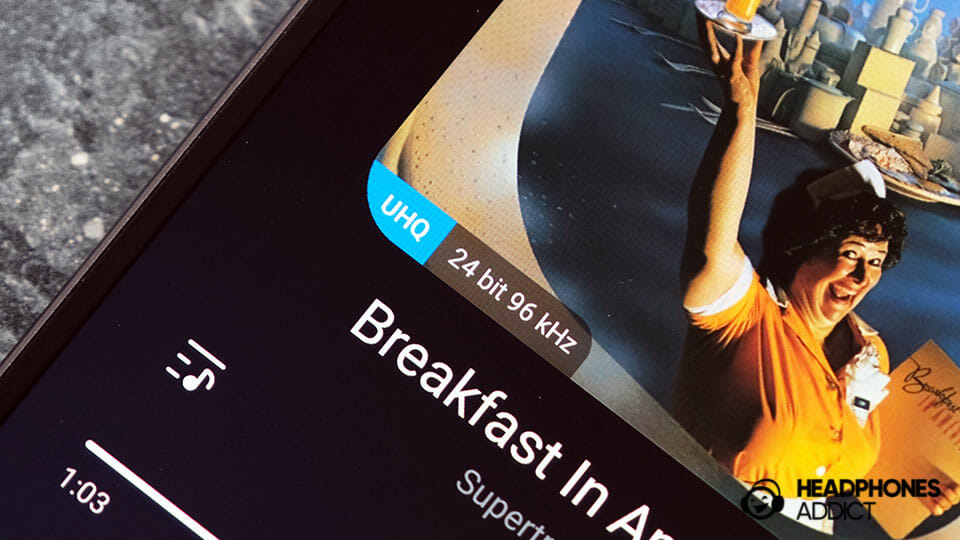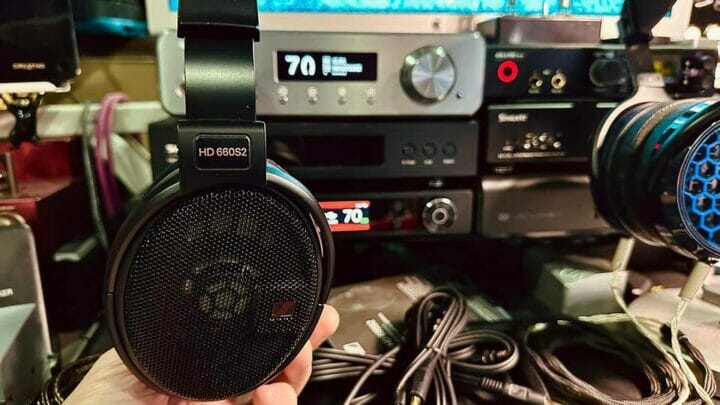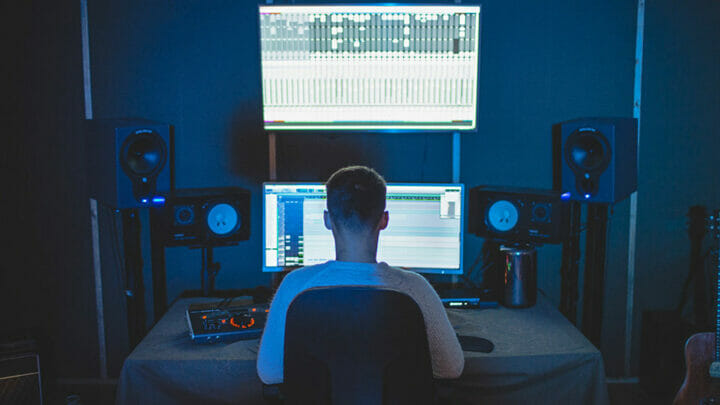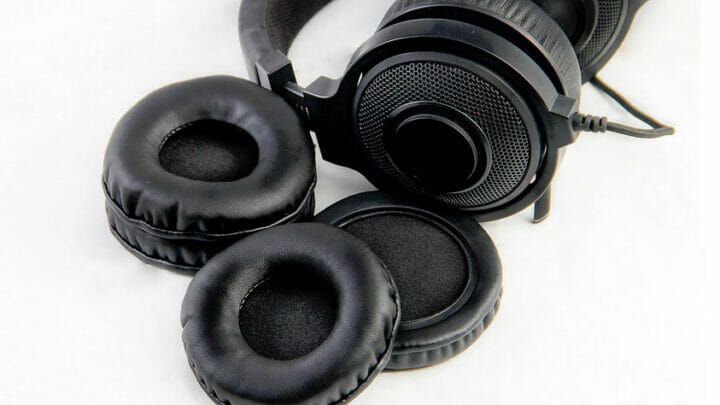- Sample rate and bit depth tell us how accurately an analog sound is sampled into a digital one.
- And bit rate determines how much data gets transferred per second.
In this article, we discuss whether higher sample rates, bit depths, and bit rates result in better sound quality and if you can benefit from it.

- Digital signal (audio) is stored in a series of binary digits that, once interpreted by a DAC, reveal the shape of an analog signal.
- Uncompressed audio files contain all original data and haven’t used any technique to reduce their size.
- Lossless audio files also contain all original data, but they can be compressed, like FLAC or ALAC.
- Compressed audio files use techniques to reduce their size and can be lossless or lossy, like MP3 or AAC.
- Sample rate reveals how many times per second an analog audio signal was sampled (on a horizontal axis).
- Nyquist frequency theorem states that to sample a song accurately, you must use twice the highest frequency for the sample rate.
- Bit depth determines how close samples are placed on an analog signal (on a vertical axis).
- Bit rate tells how much data per second is being transferred from an audio file.
How Digital Audio Works
Digital audio is 1’s and 0’s. They’re stored on your computer’s hard drive, and headphones can’t understand it. So, we need to go through a digital conversion process (with DAC) to make sense of it.
In contrast, analog audio is made of a fluctuating electrical current that headphone drivers (transducers) can play. A vinyl record is an example of analog recording, where physical vibrations are converted into electrical current.
To store music digitally, we must sample analog soundwaves and “remember” the location of those samples in a series of 1’s and 0’s.
Sample rates and bit depths tell us how accurate are samples of the sound waves.
Uncompressed audio files
Uncompressed audio files contain all the original data of the master recording. These are virgin files that haven’t gone through any compressing techniques.
They take the most digital space on your hard drive, making them unsuitable for audio streaming services.
- It’s highly recommended that audio creators always keep uncompressed audio recordings of their work. It serves as a base for any future conversion into inferior audio formats.

Lossless audio files
Lossless audio files contain all the original data from the master audio recording, just like the uncompressed audio files, but are compressed to save file size.
Examples of lossless compressed audio files are FLAC or ALAC, which contain all original data, but its file size is reduced to save hard drive space.
- As a result, these types of files are the best for storing high-resolution audio. When an audio streaming service promises high-definition audio, they offer you lossless compressed audio data.
Compressed audio files
Compressed audio files use different algorithms to rearrange digital data to save space on your hard drive. They can be lossless (as mentioned above) or lossy (MP3, AAC, OGG, etc.).
Lossy audio files remove redundant data that is inaudible to most humans to save disk space.
Most streaming services use lossy compressed audio files.
Here’s a file size comparison of the same 2 minutes 40 seconds long audio track saved in different audio formats:
| Audio format | File size |
|---|---|
| WAV | 27.2MB |
| AIFF | 27.1MB |
| FLAC (Level 8 compression) | 17.4MB |
| ALAC | 17.7MB |
| AAC (320kbps) | 6.16MB |
| MP3 (320kbps) | 7.08MB |
| OGG (320kbps) | 6.22MB |
What is Sample Rate?
Sample rate tells how many times per second an analog soundwave was sampled. Basically, how many times per second an ADC (analog to digital converter) remembered the soundwave curve’s location (on a horizontal axis).
A standard sample rate is 44.1kHz or 44.100Hz. That means a recording was sampled 44.100 times in a second.
How a sample rate impacts sound quality?
A higher sample rate is better. But not always.
The number of samples is crucial if you want to reconstruct an analog signal as close to the original as possible. If the sample rate is too low, a DAC can reconstruct completely different audio frequencies, making the sound distorted or unlistenable.
Here are a few audio clips converted in different sample rates:
Original 16-bit/44.1kHz audio:
16-bit/32kHz audio:
16-bit/16kHz audio:
16-bit/8kHz audio:
As you can hear, even 32kHz is somewhat passable but a keen ear might notice a loss of detail at the highest frequencies. On the other hand, sample rates 16kHz or lower dramatically worsen the sound quality.
That’s why you must use a sufficiently high sample rate when recording and reproducing music, as the Nyquist theorem states. More on that later.
Is a higher sample rate better?
The truth is that going beyond 44.1 kHz only adds audio resolution and details humans can’t hear.
That’s why products that promise 96kHz or even 364kHz sample rates are only selling the specs rather than actual improvements in audio fidelity.

How a sample rate impacts file size?
Sample rate has a significant impact on file size. We made a test using a 7-minute-long recording stored in 24-bit 96kHz quality that we converted in different sample rates. Here are the file sizes:
| Sample rate | File size |
|---|---|
| 192kHz | 210MB (upscaled) |
| 96kHz | 135MB (original) |
| 88.2kHz | 126MB |
| 48kHz | 80.9MB |
| 44.1kHz | 75.7MB |
| 32kHz | 58.2MB |
| 24kHz | 45.5MB |
| 22.05kHz | 42.2MB |
| 16kHz | 31.6 MB |
| 12kHz | 24.1MB |
| 8kHz | 16.3MB |
As you can see, doubling the sample rate results in almost double the file size. An audio file at 192kHz is even 2.7x bigger than at 44.1kHz without a hearable difference in audio quality.
The Nyquist theorem
The Nyquist-Shannon sampling theorem states that to sample a specific frequency accurately, you must use a sampling rate that’s twice as high.
In practice, to sample 8.000Hz, you must use a sample rate of 16.000Hz. Therefore, depending on the highest frequency in a recording, you must pick twice as high a sampling rate.
Since the human hearing range doesn’t exceed 20.000Hz (with age or inner ear damage, this threshold actually lowers), the optimal sample rate is 40.000Hz.
Today’s accepted standard is a 44.100Hz sampling rate, which is more than required. As you can see from above, any sampling frequency above that results in wasted storage space on your hard drive.
What is Bit Depth?
Bit depth dissects an analog soundwave on a vertical axis, which works in conjunction with the sampling rate to sample the soundwave more accurately.
Basically, the higher the bit depth, the more accurately you can sample the amplitude of an analog soundwave, which ensures a lower noise floor and higher dynamic range.
How a bit-depth impacts sound quality?
By sampling an analog soundwave more accurately, you avoid “quantization error”.

ADC (analog to digital conversion) or DAC (digital to analog conversion) rounds up or rounds down a sample (reconstructed signal). However, when dealing with low bit depth values, rounding up or down is more severe (a sample is placed further away from the ideal location). This negatively impacts sound quality.
That manifests in audible white noise (lower signal-to-noise ratio), changes in pitch and timbre, and lower dynamic range.
Here are a few audio clips converted in different bit depths:
Original 16-bit/44.1kHz audio:
8-bit/44.1kHz audio:
Is higher bit depth better?
A higher bit depth is better if you want to achieve maximum dynamic range and low noise. But at some point, a human ear no longer distinguishes between different bit depths.
A standard CD quality bit depth is 16 bits, whereas studio-quality recordings range from 24 to 32 bits. However, as you might have noticed from the samples above, 16 bits are more than adequate for casual listening.
The biggest difference when switching between different bit depths is in signal-to-noise ratio, or at what loudness you might start hearing unwanted noise from quantization errors.
Here are theoretical signal-to-noise ratios depending on the bit depth used:
| Bit depth | Signal-to-noise ratio |
|---|---|
| 64-bit | 387.08dB |
| 32-bit | 194.42dB |
| 24-bit | 146.26dB |
| 20-bit | 122.17dB |
| 16-bit | 98.09dB |
| 12-bit | 74.01dB |
| 8-bit | 49.93dB |
| 4-bit | 25.84dB |
Looking at the values from the table above, you would have to listen to music saved at 16-bit depth at 98dB to start hearing unwanted noise. It isn’t recommended to listen at volumes this high for very long.
At 24-bit depth, the threshold is already at 146dB, which is enough to burst your eardrum, so you’ll never listen to music that loudly.
How a bit-depth impacts file size?
Depending on the bit depth of your audio file, the difference in size can be more than double. We used a 24-bit 96kHz of a 7-minute-long recording and converted it into different bit depths. Here are the file sizes:
| Bit depth | File size |
|---|---|
| 32-bit | 280 (estimated) |
| 24-bit | 135MB (original) |
| 16-bit | 60.1MB |
| 8-bit | 20.2MB |
Based on this, a 32-bit version of our audio file would take at least 280MB of space on your hard drive.
Sample Rate vs. Bit Rate
- As discussed above, the sample rate determines how many samples there are in one second.
- And bit rate tells you how much data per second you’re getting from an audio file.
What is the relation between sample rate/bit depth and bit rate?
The bit rate value depends on the sampling rate, bit depth value, and compression. Uncompressed CD-quality 16-bit 44.1kHz file has the highest bitrate of 1,411 kilobits per second (or kbps) (when using stereo channels).
However, with a FLAC, which is lossless but compressed, kbps values usually go below 1,000kbps while retaining that CD-quality audio playback.
Here are some examples of bit rates depending on the audio file quality:
| Audio file quality | Estimated bit rate |
|---|---|
| 24-bit 192kHz | – 9,216 kbps (uncompressed) |
| 24-bit 96kHz | – 4,608 kbps (uncompressed) – Below 3,000kbps (FLAC) |
| 16-bit 44.1kHz | – 1,411kbps (uncompressed) – Below 1,000kbps (FLAC) – 320kbps (MP3) – 256kbps (AAC) |
In Bluetooth headphones, you also have to consider bandwidth, which determines the maximum bit rate over a wireless connection. It varies depending on which Bluetooth codec you’re using.
What are the best audio file quality settings?
The best audio file settings depend on how you plan to use the file.
- If you’re capturing audio, it’s best to record it with the best possible settings. That way, you can edit your mix without fear of losing data in the process, which can lead to worse sound quality.
- If you’re working on a project, you should save your audio masters in the same quality as they were recorded. You can always downsample a recording, but you can’t up-sample it back once you lose data.
- If you’re an audiophile and want the best possible music experience, 24-bit 48/44.1kHz is more than enough. Going higher only contributes to larger files. Any additional information will be inaudible to humans anyway.
- For casual listening, 320kbps MP3 or 256kbps AAC is plenty enough since most people can’t distinguish between an MP3 and a FLAC.
| How you’ll use an audio file | Audio file settings |
|---|---|
| Recording audio | Best possible settings |
| Working on an audio project | Best possible settings |
| Audiophile listening session | 24-bit & 48/44.1kHz |
| Casual listening | 16-bit & 44.1kHz, 320kbps MP3, 256kbps AAC |
Frequently Asked Questions (FAQ)
What sampling rate is best for sound?
The sampling rate best for sound is 44.1kHz or 44.100Hz. That’s enough to sample all frequencies audible to humans accurately. While higher sampling rates can be measurably better, they’re irrelevant as humans can’t hear the difference.
Which is better 48kHz or 44.1kHz?
Technically, 48kHz is better than 44.1kHz, but in real-world applications, humans can’t hear the difference. Meaning that the 44.1kHz sampling rate is more than enough, even for higher resolution audio.
Is a higher sampling rate better?
A higher sampling rate is better as it samples an analog soundwave more accurately. However, going higher than 44.1kHz doesn’t make sense, as the added detail from more accurate sampling is inaudible to humans.
Conclusion
Hopefully, you now understand how sample rate, audio bit depth, and bit rate affect your music. And why the race to have the highest specs doesn’t matter.
Professional audio engineers must record at higher bit depths and sample rates to ensure their recording doesn’t degrade during audio production and editing.
On the other hand, 16 bits and 44.1kHz are perfectly fine for casual listening. And you also have to consider other elements in your audio system when seeking better audio quality, like how good is your DAC or amplifier?

From a childhood fascination with sound, Peter’s passion has evolved into a relentless pursuit of the finest headphones. He’s an audio expert with over 5 years of experience in testing both audiophile and consumer-grade headphones. Quote: “After many years, I can confidently tell which headphones are good and which are terrible.” Find his honest opinion in his reviews.



